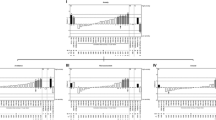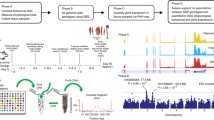Abstract
Advanced intercross lines (AIL) and interval–specific congenic strains (ISCS) were used to fine map previously coarsely defined quantitative trait loci (QTL) on Chromosomes 1,10, and 19, influencing behaviors in the open Field (OF) and light–dark (LD) paradigms in mice. F12(A × B) AIL mice (N = 1130) were phenotyped, genotyped, and mapped. The ISCS were studied only in the telomeric Chromosome 10 region of interest, containing the exploratory and excitability QTL1 (Exq1). The Chromosome 10 Exq1 and Chromosome 19 Exq4 loci mapped robustly in the AIL. The most significant QTL findings (2.0 LOD score intervals; peak; LOD score) came from the TD15 and LD transitions traits, yielding estimated intervals of 2.2 cM for Exq1 (71.3–73.5 cM; peak 72.3 cM; LOD 11.9) and 9.0 cM for Exq4 (29.0–38.2 cM; peak 34 cM; LOD 4.2). The replicated QTLs on Chromosome 1 failed to map in this AIL population. The ISCS data confirmed Exq1 loci in general. However, the ISCS data were complex and less definitive for localizing the Exq1 loci. These exploratory and fear-like behaviors result from inheriting “many small things,” namely, QTL explaining 2%–7% of the phenotypic variance. These results highlight the challenges of positionally cloning loci of small effect for complex traits. In particular, fine-mapping success may depend on the genetic architecture underlying complex traits.


Similar content being viewed by others
References
Aguilar R, Gil L, Flint J, Gray JA, Dawson GR, et al. (2002) Learned fear, emotional reactivity and fear of heights: a factor analytic map from a large F(2) intercross of Roman rat strains. Brain Res Bull 57(1), 17–26
Aiken LS, West SG (1991) Multiple Regression: Testing and Interpreting Interactions (Thousand Oaks, CA: Sage Publications)
Archer J (1973) Tests for emotionality in rats and mice: A review. Anim Behav 21, 205–235
Bolivar VJ, Cook MN, Flaherty L (2001) Mapping of quantitative trait loci with knockout/congenic strains. Genome Res 11(9), 1549–1552
Botstein D, Risch N (2003) Discovering genotypes underlying human phenotypes: past successes for Mendelian disease, future approaches for complex disease. Nat Genet 33 Suppl, 228–237
Broman KW, Speed TP (2002) A model selection approach for the identification of quantitative trait loci in experimental crosses. J R Stat Soc B 64, 641–656
Caldarone B, Saavedra C, Tartaglia K, Wehner JM, Dudek BC, et al. (1997) Quantitative trait loci analysis affecting contextual conditioning in mice, Nat Genet 17(3), 335–337
Cheverud JM, Routman EJ (1995) Epistasis and its contribution to genetic variance components. Genetics 139(3), 1455–1461
Crawley JN (1981) Neuropharmacologic specificity of a simple animal model for the behavioral actions of benzodiazepines. Pharmacol Biochem Behav 15(5), 695–699
Darvasi A (1998) Experimental strategies for the genetic dissection of complex traits in animal models. Nat Genet 18(1), 19–24
Darvasi A, Soller M (1995) Advanced intercross lines, an experimental population for fine genetic mapping. Genetics 141(3), 1199–1207
DeFries JC, Gervais MC, Thomas EA (1978) Response to 30 generations of selection for open-field activity in laboratory mice. Behav Genet 8(1), 3–13
Flint J (2003) Analysis of quantitative trait loci that influence animal behavior. J Neurobiol 54(1), 46–77
Fortin A, Diez E, Rochefort D, Laroche L, Malo D, et al. (2001) Recombinant congenic strains derived from A/J and C57BL/6J: a tool for genetic dissection of complex traits. Genomics 74(1), 21–35
Fridman E, Liu YS, Carmel-Goren L, Gur A, Shoresh M, et al. (2002) Two tightly linked QTLs modify tomato sugar content via different physiological pathways. Mol Genet Genomics 266(5), 821–826
Gershenfeld HK, Paul SM (1997) Mapping quantitative trait loci for fear-like behaviors in mice. Genomics 46(1), 1–18
Gershenfeld HK, Neumann PE, Mathis C, Crawley JN, Li X, et al. (1997) Mapping quantitative trait loci for open-field behavior in mice. Behav Genet 27(3), 201–10
Gershenfeld HK, Neumann PE, Li X, St Jean PL, Paul SM (1999) Mapping quantitative trait loci for seizure response to a GABAA receptor inverse agonist in mice. J Neurosci 19(10), 3731–3738
Hardy MA (1993) Regression with Dummy Variables (Thousand Oaks, CA: Sage Publications, Inc.)
Harrell FE Jr. (2001) Regression Modelling Strategies (New York: Springer-Verlag)
Iraqi F (2000) Fine mapping of quantitative trait loci using advanced intercross lines of mice and positional cloning of the corresponding genes. Exp Lung Res 26(8), 641–649
Jaccard J, Turrisi R (2003) Interaction Effects in Multiple Regression (Thousand Oaks, CA: Sage Publications, Inc.)
Jiang C, Zeng ZB (1995) Multiple trait analysis of genetic mapping for quantitative trait loci. Genetics 140(3), 1111–1127
Kerlavage A, Bonnazzi V, di Toshmaso M, Lawrence C, Li P, et al. (2002) The Celera Discovery System. Nucleic Acids Res 30(1), 129–136
Knott SA, Haley CS (2000) Multitrait least squares for quantitative trait loci detection. Genetics 156(2), 899–911
Kumanovics A, Takada T, Lindahl KF (2003) Genomic organization of the mammalian MHC. Annu Rev Immunol 21, 629–657
Laird PW, Zijderveld A, Linders K, Rudnicki MA, Jaenisch R, et al. (1991) Simplified mammalian DNA isolation procedure. Nucleic Acids Res 19(15), 4293
Legare ME, Bartlett FS 2nd, Frankel WN (2000) A major effect QTL determined by multiple genes in epileptic EL mice. Genome Res 10(1), 42–48
Liu BH (1998) Statistical Genomics: Linkage, Mapping, and QTL Analysis (Boca Raton, FL CRC Press)
Liu X, Gershenfeld HK (2003) An exploratory factor analysis of the Tail Suspension Test in 12 inbred strains of mice and an F2 intercross. Brain Res Bull 60(3), 223–231
Long AD, Lyman RF, Langley CH, Mackey TF (1998) Two sites in the Delta gene region contribute to naturally occurring variation in bristle number in Drosophila melanogaster. Genetics 149(2), 999–1017
Mackay TF (2001) The genetic architecture of quantitative traits. Annu Rev Genet 35, 303–339
Manly KF, Olson JM (1999) Overview of QTL mapping software and introduction to Map Manager QT. Mamm Genome 10(4), 327–334
Markel P, Shu P, Ebeling C, Carlson GA, Nagle DL, et al. (1997) Theoretical and empirical issues for marker-assisted breeding of congenic mouse strains. Nat Genet 17(3), 280–284
Mathis C, Paul SM, Crawley JN (1994) Characterization of benzodiazepine-sensitive behaviors in the A/J and C57BL/6J inbred strains of mice. Behav Genet 24(2), 171–180
Morel L, Blenman KR, Croker BP, Wakeland EK (2001) The major murine systemic lupus erythematosus susceptibility locus, Sle1, is a cluster of functionally related genes. Proc Natl Acad Sci USA 98(4), 1787–1792
Mott R, Talbot CJ, Turri MG, Collins AC, Flint J (2000) A method for fine mapping quantitative trait loci in outbred animal stocks. Proc Natl Acad Sci USA 97(23), 12649–12654
Nadeau JH, Singer JB, Matin A, Lander ES (2000) Analysing complex genetic traits with chromosome substitution strains. Nat Genet 24(3), 221–225
Ramos A, Berton O, Mormede P, Chaouloff F (1997) A multiple-test study of anxiety-related behaviours in six inbred rat strains. Behav Brain Res 85(1), 57–69
Sampson SB, Higgins DC, Elliot RW, Taylor BA, Lueders KK, et al. (1998) An edited linkage map for the A × B and B × A recombinant inbred mouse recombinant inbred mouse strains. Mamm Genome 9(9), 688–694
Seaton G, Haley CS, Knott SA, Kearsey M, Visscher PM (2002) QTL Express: mapping quantitative trait loci in simple and complex pedigrees. Bioinformatics 18(2), 339–340
Singer JB, Hill AE, Burrage LC, Olszens KR, Song J, et al. (2004) Genetic dissection of complex traits with chromosome substitution strains of mice. Science 304(5669), 445–448
Snell GD (1981) Studies in histocompatibility. Science 213(4504), 172–178
Stefansson H, Sigurasson E, Steinthorsdottir V, Bjornsdottir S, Sigmundsson T, et al. (2002) Neuregulin 1 and susceptibility to schizophrenia. Am J Hum Genet 71(4), 877–892
Stefansson H, Sarginson J, Kong A, Yates P, Steinthorsdottir V, et al. (2003) Association of neuregulin 1 with schizophrenia confirmed in a Scottish population. Am J Hum Genet 72(1), 83–87
Steinmetz LM, Sinha H, Richards DR, Spiegelman JI, Oefner PJ, et al. (2002) Dissecting the architecture of a quantitative trait locus in yeast. Nature 416(6878), 326–330
Talbot CJ, Nicod A, Cherny SS, Fulker DW, Collins AC, et al. (1999) High-resolution mapping of quantitative trait loci in outbred mice. Nat Genet. 21(3), 305–308
Talbot CJ, Radcliffe RA, Fullerton J, Hitzmann R, Wehner JM, et al. (2003) Fine scale mapping of a genetic locus for conditioned fear. Mamm Genome 14 (4), 223–230
Turri MG, Datta SR, DeFries J, Henderson ND, Flint J et al. (2001). QTL analysis identifies multiple behavioral dimensions in ethological tests of anxiety in laboratory mice. Curr Biol 11(10), 725–734
Turri MG, Henderson ND, DeFries JC, Flint J (2001) Quantitative trait locus mapping in laboratory mice derived from a replicated selection experiment for open-field activity. Genetics 158(3), 1217–1226
Wakeland E, Morel L, Achey K, Yui H, Longmate J (1997) Speed congenics: Speed congenics: a classic technique in the fast lane (relatively speaking). Immunol Today 18(10), 472–477
Wang M, Lemon WJ, Liu G, Wang Y, Iragi FA, et al. (2003) Fine mapping and identification of candidate pulmonary adenoma susceptibility 1 genes using advanced intercross lines. Cancer Res 63(12), 3317– 3324
Waterston RH, Lindblad-Toh K, Birney E, Rogers J, Abril JF, et al. (2002) Initial sequencing and comparative analysis of the mouse genome. Nature 420(6915), 520–562
Wehner JM, Radcliffe RA, Rossman ST, Christensen SC, Rasmussen DL, et al. (1997) Quantitative trait locus analysis of contextual fear conditioning in mice. Nat Genet 17(3), 331–334
Yalcin B, Willis-Owen SA, Fullerton J, Meesaq A, Deacon RM, et al. (2004) Genetic dissection of a behavioral quantitative trait locus shows that Rgs2 modulates anxiety in mice. Nat Genet 36(11), 1197–1202
Zhang Z, Futamura M, Vikis MG, Wang M, Li J, et al. (2003). Positional cloning of the major quantitative trait locus underlying lung tumor susceptibility in mice. Proc Natl Acad Sci USA 100(22), 12642–12647
Acknowledgments
We thank Ming You (Washington University) for insightful comments on the manuscript along with the anonymous reviewers. We appreciate our ILRI and UTSW colleagues for helpful conversations. We are extraordinarily grateful to the Mammalian Genotyping Service for skillfully genotyping the F12 population (James Weber, Marshfield Clinic). We appreciated Paul Neumann’s (Dalhousie University) idea in 1995 for the ISCS strategy, the Mouse Genome Project, Ken Manly for QTX Manager, Ensembl, and the Mouse Genome Informatics Project for providing the facilitating infrastructure for this work. This project has been generously supported by the Southwestern Medical Foundation, Texas Higher Education Coordinating Board ARP (010019-0081-1999), and National Institutes of Health R01-MH58882 (HG).
Author information
Authors and Affiliations
Corresponding author
Additional information
Shumin Zhang, Yigong Lou and Howard Gershenfeld contributed equally to this work.
Abbreviations: ROI, Region of Interest; RI, recombinant inbred; AIL, advanced intercross line; ISCS, Interval-specific congenic strains; Sqrt, square root; QTL, quantitative trait loci; OF, open field; LOD, likelihood of the odds ratio score; Tde1, traveled distance epoch 1; TDe3, traveled distance epoch 3; TD15, traveled distance during 15 min; VM15, vertical movements during 15 min ; LD, light–dark transitions; AvgCtrT, average center time; Chr, chromosome; Exq, exploratory and excitability QTL.
Rights and permissions
About this article
Cite this article
Zhang, S., Lou, Y., Amstein, T.M. et al. Fine mapping of a major locus on Chromosome 10 for exploratory and fear-like behavior in mice. Mamm Genome 16, 306–318 (2005). https://doi.org/10.1007/s00335-004-2427-8
Received:
Accepted:
Issue Date:
DOI: https://doi.org/10.1007/s00335-004-2427-8




